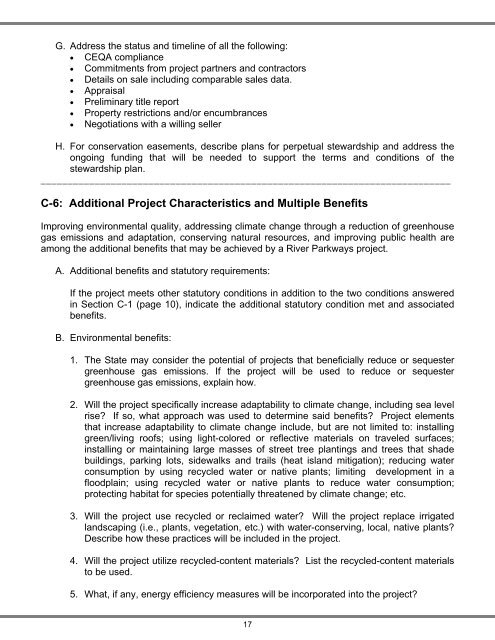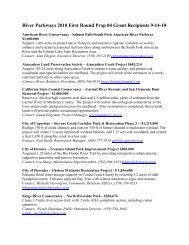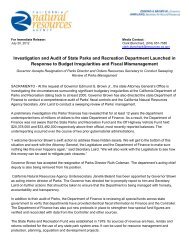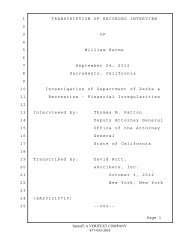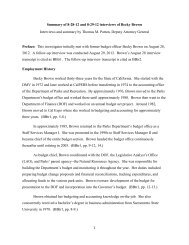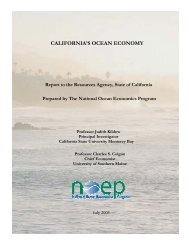california river parkways grant program - California Resources Agency
california river parkways grant program - California Resources Agency
california river parkways grant program - California Resources Agency
You also want an ePaper? Increase the reach of your titles
YUMPU automatically turns print PDFs into web optimized ePapers that Google loves.
G. Address the status and timeline of all the following:<br />
• CEQA compliance<br />
• Commitments from project partners and contractors<br />
• Details on sale including comparable sales data.<br />
• Appraisal<br />
• Preliminary title report<br />
• Property restrictions and/or encumbrances<br />
• Negotiations with a willing seller<br />
H. For conservation easements, describe plans for perpetual stewardship and address the<br />
ongoing funding that will be needed to support the terms and conditions of the<br />
stewardship plan.<br />
____________________________________________________________________________<br />
C-6: Additional Project Characteristics and Multiple Benefits<br />
Improving environmental quality, addressing climate change through a reduction of greenhouse<br />
gas emissions and adaptation, conserving natural resources, and improving public health are<br />
among the additional benefits that may be achieved by a River Parkways project.<br />
A. Additional benefits and statutory requirements:<br />
If the project meets other statutory conditions in addition to the two conditions answered<br />
in Section C-1 (page 10), indicate the additional statutory condition met and associated<br />
benefits.<br />
B. Environmental benefits:<br />
1. The State may consider the potential of projects that beneficially reduce or sequester<br />
greenhouse gas emissions. If the project will be used to reduce or sequester<br />
greenhouse gas emissions, explain how.<br />
2. Will the project specifically increase adaptability to climate change, including sea level<br />
rise? If so, what approach was used to determine said benefits? Project elements<br />
that increase adaptability to climate change include, but are not limited to: installing<br />
green/living roofs; using light-colored or reflective materials on traveled surfaces;<br />
installing or maintaining large masses of street tree plantings and trees that shade<br />
buildings, parking lots, sidewalks and trails (heat island mitigation); reducing water<br />
consumption by using recycled water or native plants; limiting development in a<br />
floodplain; using recycled water or native plants to reduce water consumption;<br />
protecting habitat for species potentially threatened by climate change; etc.<br />
3. Will the project use recycled or reclaimed water? Will the project replace irrigated<br />
landscaping (i.e., plants, vegetation, etc.) with water-conserving, local, native plants?<br />
Describe how these practices will be included in the project.<br />
4. Will the project utilize recycled-content materials? List the recycled-content materials<br />
to be used.<br />
5. What, if any, energy efficiency measures will be incorporated into the project?<br />
17


